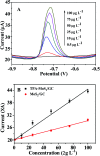Thiolated poly(aspartic acid)-functionalized two-dimensional MoS2, chitosan and bismuth film as a sensor platform for cadmium ion detection
- PMID: 35515180
- PMCID: PMC9057193
- DOI: 10.1039/d0ra06197b
Thiolated poly(aspartic acid)-functionalized two-dimensional MoS2, chitosan and bismuth film as a sensor platform for cadmium ion detection
Abstract
In this work, a sensitive electrochemical platform for determination of cadmium ions (Cd2+) is obtained using thiolated poly(aspartic acid) (TPA)-functionalized MoS2 as a sensor platform by differential pulse anodic stripping voltammetry (DPASV). The performance of the TPA-MoS2-modified sensor is systemically studied. It demonstrates that the TPA-MoS2 nanocomposite modified sensor exhibits superior analytical performance for Cd2+ over a linear range from 0.5 μg L-1 to 50 μg L-1, with a detection limit of 0.17 μg L-1. Chitosan is able to form a continuous coating film on the surface of the GC electrode. The good sensing performance of the TPA-MoS2-modified sensor may be attributed to the following factors: the large surface area of MoS2 (603 m2 g-1), and the abundant thiol groups of TPA. Thus, the TPA-MoS2-modified sensor proves to be a reliable and environmentally friendly tool for the effective monitoring of Cd2+ existing in aquacultural environments.
This journal is © The Royal Society of Chemistry.
Conflict of interest statement
There is no conflicts of interest.
Figures






Similar articles
-
Synergetic Sensing Effect of Sodium Carboxymethyl Cellulose and Bismuth on Cadmium Detection by Differential Pulse Anodic Stripping Voltammetry.Sensors (Basel). 2019 Dec 12;19(24):5482. doi: 10.3390/s19245482. Sensors (Basel). 2019. PMID: 31842415 Free PMC article.
-
A novel electrochemical sensor for simultaneous detection of Cd2+ and Pb2+ by MXene aerogel-CuO/carbon cloth flexible electrode based on oxygen vacancy and bismuth film.Sci Total Environ. 2022 Dec 10;851(Pt 2):158325. doi: 10.1016/j.scitotenv.2022.158325. Epub 2022 Aug 28. Sci Total Environ. 2022. PMID: 36041599
-
Development of an electrochemically reduced graphene oxide modified disposable bismuth film electrode and its application for stripping analysis of heavy metals in milk.Food Chem. 2014 May 15;151:65-71. doi: 10.1016/j.foodchem.2013.11.026. Epub 2013 Nov 17. Food Chem. 2014. PMID: 24423503
-
Synthesis of a novel electrode material containing phytic acid-polyaniline nanofibers for simultaneous determination of cadmium and lead ions.Anal Chim Acta. 2016 Dec 1;947:32-41. doi: 10.1016/j.aca.2016.10.012. Epub 2016 Oct 14. Anal Chim Acta. 2016. PMID: 27846987
-
Comparative study of graphene nanosheet- and multiwall carbon nanotube-based electrochemical sensor for the sensitive detection of cadmium.Anal Chim Acta. 2014 Dec 3;851:43-8. doi: 10.1016/j.aca.2014.08.021. Epub 2014 Aug 15. Anal Chim Acta. 2014. PMID: 25440663
References
-
- Knani L. Venditti M. Kechiche S. Banni M. Messaoudi I. Minucci S. Toxicol. Mech. Methods. 2019:1–9. - PubMed
LinkOut - more resources
Full Text Sources
Miscellaneous

